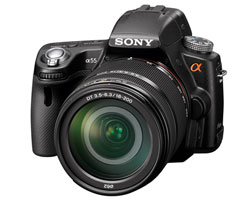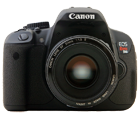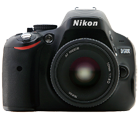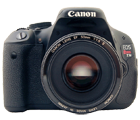Sony SLT-A55 Features

Available at Amazon, Adorama and B&H Photo Video
Introduction
The Sony SLT-A55 features an exterior that looks a lot like a traditional SLR and an interior that's fundamentally different.
Instead of a mirror that reflects light up to an optical viewfinder, the SLT-A55 has a partially transparent mirror: some of the light passes through to the camera's sensor and some is bounced up to a sensor for the electronic viewfinder.
I'll explain the benefit of this system in more detail below, but here's the quick overview: this camera is fast.
Whether you use the viewfinder or the LCD to compose images, autofocus will be equally snappy. Furthermore, you can capture consecutive images at a rate of 10 per second, a speed previously only available to very high end professional cameras.
In addition to speed, the SLT-A55 has a Full HD 1080i video mode and a flexible 3 inch LCD screen to help you compose pictures and videos from all sorts of odd angles.
This innovative feature set convinced me to pick the Sony SLT-A55 as the best digital SLR of 2010.
Feature List
| Megapixels | 16.2 |
|---|---|
| Stabilization | In Body |
| Memory Card | SD / SDHC / SDXC |
| Max. Shutter Speed | 1/4000 |
| Max. Photo Capture | 10 per second |
| ISO Range | 100 to 12800 |
| Movie Modes | AVCHD 1920 x 1080i Motion JPEG 1440 x 1080 640 x 480 |
| LCD | Flexible 3in (921,600 dots) |
| Viewfinder | Electronic |
| Autofocus | 15 point |
| Face Detect AF | Yes |
| Sensor Dimensions | 23.4 x 15.6 (1.5x crop factor) |
| HDMI Port | Yes |
| Live View | Yes |
| Built-in Flash | Yes |
| Compatible Lenses | All Sony ALPHA |
| Battery | NP-FW50 LiIon |
| Dimensions | 4.8 x 3.6 x 3.3in 124 x 92 x 85mm |
| Weight | 15.3oz (433g) |
New and Notable

Clearly, what's new and notable on the SLT-A55 is that translucent mirror. But what - exactly - does the translucent mirror do for you when you want to take pictures?
In a traditional SLR camera system, a mirror sits directly in front of the camera's digital sensor. This mirror reflects light up to the camera's optical viewfinder so when you look through it you see exactly what the lens sees.
Every time you take a picture, the mirror flips up out of the way of the digital sensor so that it can be exposed to light.
When the mirror flips up, it temporarily disables the camera's autofocus system (the autofocus mechanism is located in the direction of the viewfinder, which is blocked when the mirror is up).
The mirror is in the "up" position at three different times:
- Every time you take a photo
- When you use the live view mode
- When you capture video
If you're just taking a picture, then the autofocus is only disabled for a split second. But what happens when the mirror is flipped up for a long time when you use live view mode or want to capture video?
In these cases, the camera resorts to a secondary autofocus system that's not nearly as fast as the primary one.
The primary autofocus in any DSLR is also called phase detection — it's this system that allows you to focus (even on moving subjects) in fractions of seconds. The secondary autofocus is called contrast detection and it's the type of autofocus used in compact digital cameras.
The main difference between the two: speed. Phase-detection autofocus systems are substantially faster than contrast-detection systems.
This means that on most digital SLRs, autofocus in live view mode and during video capture is MUCH slower than it is when you're just taking still pictures. The translucent mirror system is designed to address this limitation.
Since the translucent mirror both reflects light up to the viewfinder AND allows light to pass through to the sensor, the phase-detection autofocus can be used in both live view and video capture mode.
This should result in much better autofocus performance regardless of how you're trying to use the camera.
The second side benefit is that cameras with a system like this are capable of MUCH faster continuous shutter speeds.
The main drawback to a translucent mirror system is that you give up the optical viewfinder for an electronic one. Electronic viewfinders often don't have the same level of clarity as optical ones since they are really just tiny monitors stuck inside the camera's viewfinder.
The advantage that electronic viewfinders have over their optical counterparts is that camera settings (and other special displays like grids and horizon line levels) can be super-imposed on the viewfinder image.

|



